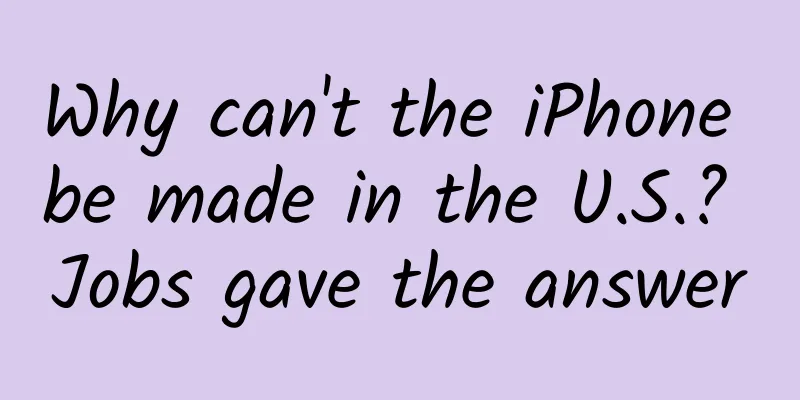Why can't the iPhone be made in the U.S.? Jobs gave the answer

|
If Jobs' attempt to manufacture Apple computers in the United States had not failed, perhaps Trump would not have to try every means to force Apple to move the iPhone assembly supply chain back to the United States today. Since Trump took office, in order to revitalize the American manufacturing industry, he has been pushing Apple and other technology giants to move their production lines back to the United States. He even imposed punitive tariffs on China for this purpose. Bloomberg wrote last week that if the tariff is increased to 25%, Apple's supply chain will consider moving the iPhone production line out of China.
In fact, in response to Trump's call, Apple announced at the beginning of the year that it had launched a $245 billion plan to return to the United States. This year, Apple has added 6,000 jobs to the U.S. labor market, and last week announced that it would spend $1 billion to build a new campus. However, the production and assembly of major products such as the iPhone and iPad still rely on China and other countries with lower labor costs. The fate of Apple's American manufacturing may have been doomed more than 30 years ago. How did the American-made Apple computer become a mess? In the 1980s, large American technology companies including Dell, HP and Compaq moved their production lines from their home country to overseas regions such as Asia in order to reduce costs. However, Apple did not do so, because Jobs believed that software and hardware development must be closely integrated. So instead of closing the factory, Apple decided to open new factories in states such as California, Colorado and Texas to produce Apple computers.
In 1983, Apple built a factory in California to produce Macintosh personal computers, located across from Apple's headquarters at the time. According to a reporter who visited the factory at the time, the factory was highly automated, with labor accounting for only 2% of the total manufacturing cost. Jobs was very proud of the Macintosh computers produced here: “This is an American-made machine.” The decoration of the factory also maintained Apple's consistent minimalist style, and the walls were uniformly painted white. Jobs hoped to establish a manufacturing culture similar to the Japanese craftsmanship. Randy Battat, who was an electrical engineer at Apple, recalled: Steve had a firm belief in Japanese manufacturing technology. The Japanese were known as magicians in manufacturing, and our goal was to build a factory that could deliver on time with zero defects in parts.
But before the factories were on track, Jobs was forced to leave Apple in 1985. Many of these factories were still retained, but they became a major failure in Jobs' career at Apple and left Apple in a mess. In 1988, Jean-Louis Gassée, an automation expert from France, was appointed Apple's product director by then-Apple CEO John Sculley to take over the manufacturing of Apple products. After Gassée spent two days learning about Apple's "highly automated" factory in California, he found that the American manufacturing production line created by Jobs was actually not successful.
Gassée recalled in an interview with The New York Times that at the end of one shift, he picked up a broom and swept through the parts that had fallen on the production line. Gassée thought it was "really a shame." Until 1992, all Macintosh production lines in the United States were closed. These factories had never achieved the production that Jobs had originally envisioned. The sharp drop in Mac computer sales in the mid-1990s also caused a surge in inventory. Apple was forced to accept production outsourcing, and the dream of local manufacturing was officially shattered.
In fact, after leaving Apple, Jobs invested $10 million to build a factory to manufacture NeXT personal workstations, but it also ended in failure. These two failures also made Jobs no longer stubborn. After taking over Apple again, he appointed Tim Cook from Compaq as senior vice president of global operations, and Apple's global supply chain layout began.
Currently, Apple's supply chain covers mainland China, Taiwan, Japan, South Korea and other countries and regions, and the proportion of Chinese suppliers is increasing year by year. Zhengzhou, where Foxconn is located, has become an "Apple City" and can produce 500,000 iPhones every day. The 60,000 young people in Shanghai Rocket Village have produced half of the world's iPhones. Facts have also proved that Silicon Valley has not affected product development due to outsourcing of the supply chain, but has become the world's leading industrial and software design center. The house price at the old site of Apple's Macintosh factory has risen to $1.1 million, and it is almost impossible for Apple to set up a production line in such a place. It's not easy to make iPhones in the US again As we all know, lower labor costs in overseas countries and regions are an important reason why Apple chooses to manufacture products such as iPhones in China and other countries. Trump wants the iPhone to be assembled and produced back in the United States. In addition to using the threat of significantly increasing import tariffs, he also spent real money to lure Foxconn. Last year, the Wisconsin government offered up to $4 billion in economic incentives to attract Foxconn to build a factory, on the condition that Foxconn invest $10 billion in the state and create 13,000 jobs. This is the largest subsidy the United States has ever provided to a foreign company. In June this year, Trump personally attended the groundbreaking ceremony of the Foxconn factory and praised it as "the eighth wonder of the world." However, the main business of this factory is the production of LCD display panels. As Apple gradually embraces OLED screens, LCD screens may have been completely abandoned by Apple after the completion of Foxconn's US factory. This factory is unlikely to become a turning point for the iPhone to return to US manufacturing. In the current context of economic globalization, it is much more difficult to bring iPhone manufacturing back to the United States than Trump says. To understand why Apple does not manufacture iPhones in the United States, we must first look at why Apple chooses China and other countries to produce iPhones. In fact, this cannot be simply summarized by the low cost of labor and land. The workers' operating skills and proficiency, and the factory's flexible adjustment of product lines are all difficult to achieve in the United States. Of course, huge government subsidies and cheap labor are important reasons why China attracts Apple. The New York Times has investigated Foxconn's Zhengzhou factory, a city of 6 million people now known as "Apple City" by locals, which can produce 500,000 iPhones a day. It is reported that in order to attract Apple to settle down, the local government provided Foxconn with more than 1.5 billion US dollars (about 10.3 billion RMB) to build infrastructure such as power plants and employee dormitories, and invested more than 10 billion US dollars (about 69 billion RMB) to expand the airport and provide extremely convenient customs clearance procedures. This world's largest iPhone factory began operation in 2010, when Zhengzhou's GDP was only 400 billion RMB. In addition to lower labor costs, China also has more skilled workers who can perform tasks better. An Apple executive once estimated that it would take about 8,700 industrial engineers to manage and guide the 200,000 assembly line workers who make iPhones. Apple analysts predict that it would take nine months to recruit so many qualified engineers in the United States. In China, it only takes 15 days. The degree to which Chinese factories fulfilled iPhone production needs also exceeded Apple's expectations. A former Apple executive once told the New York Times: Apple changed the iPhone screen design at the last minute, requiring the entire assembly line to be refitted. The new screen panels arrived at the factory at midnight. A foreman woke up 8,000 workers sleeping in the dormitory, gave each of them a biscuit and a cup of tea, and took their positions within half an hour to start a 12-hour workday. They embedded each new screen into the panel. In just 96 hours, the factory's output reached 10,000 iPhones a day. The former Apple executive commented on the Chinese production line workers: "Their speed and flexibility are incredible, and no American factory can match it."
With high-quality and low-cost services, Chinese suppliers are increasingly being used by Apple. According to Apple's list of the top 200 suppliers in 2018, the number of suppliers from mainland China increased from 27 last year to 34. In addition, Taiwan has the largest number of suppliers, with 51. On the contrary, the number of suppliers from the United States has decreased. Apple said that these 200 suppliers accounted for 98% of Apple's global raw materials, manufacturing and assembly expenses in 2017, which also shows Apple's reliance on Chinese suppliers. In addition to the increase in the number of Chinese suppliers, among the six most important parts of Apple products (display panels, semiconductor devices, camera modules, functional devices, passive components and structures), the number of Chinese suppliers involved has increased from three last year to five this year. In 2012, Apple only announced eight suppliers in mainland China. Judging from the current growth trend, although Trump has been advocating "Made in the USA", Apple's layout of overseas supply chains in China and other places has continued to increase. If this trend continues, Chinese suppliers may even threaten the United States' leading position in semiconductors, which is also considered to be one of the reasons why Trump is determined to provoke a trade war between China and the United States at all costs. Is it feasible to manufacture iPhones in the United States? Is it feasible to produce and assemble iPhones in the United States? MIT Technology Review analyzed three options:
According to the analysis of the MIT research team, the first option will increase the production cost of an iPhone by 30-40 US dollars. In addition to the higher labor costs in the United States, it is mainly due to the need to pay higher logistics costs. This is already the most expensive of the three options. If Apple were to produce parts in the U.S., the cost would increase by at least $100. For example, the iPhone's most expensive component, the screen, is mainly outsourced to Samsung and TSMC, with factories concentrated in Asia. U.S. factories are unable to meet production capacity requirements. As for the production raw materials, they are innate conditions. Mobile phone production requires various rare earth materials. For example, the bauxite needed for the iPhone's aluminum alloy shell is not available in the United States, and currently 80% of the world's rare earth supply comes from China. It can be seen that it is unlikely that everything from the supply of mobile phone raw materials to production and assembly can be completed in one country. At the same time, in order to improve efficiency and save costs, the supply chain also has a clustering effect.
When factories assembling products are concentrated in one area, suppliers of parts will also move closer. Corning, which provides Gorilla Glass to Apple, moved most of its production lines from the United States to Japan and Taiwan a few years ago. James Flaws, Corning's chief financial officer, once said:
Currently, Apple's supply chain is concentrated in East Asia, with suppliers in China, Japan and South Korea accounting for nearly 70% of the world's total. This has created a powerful economy of scale, and it is not realistic to transfer them on a large scale. Therefore, if Trump really wants Apple to manufacture iPhones in the United States, in addition to persuading Apple, he must also find a way to move the entire production and assembly supply chain to the United States. He also needs to train a large number of technical workers. Currently, Foxconn in Wisconsin is facing the dilemma of not being able to recruit people and having to dispatch engineers from China. Manufacturing Apple products in the United States may seem like an impossible task. Title image from: iFixit |
Recommend
Detailed explanation of using Android HOOK tool Cydia Substrate
Cydia Substrate is a code modification platform. ...
Simply copy and paste, you can easily get 100+ traffic a day on Weibo to make money
Hotspot traffic Weibo, the social platform with t...
Korean automakers offer huge subsidies in the U.S. to maintain sales, but remain indifferent to the decline in the Chinese market
Korean automakers really need to think carefully ...
Community operation: Does your group need to be active?
1. Does your group need to be active? Group activ...
A reusable marketing promotion plan
Currently, the hottest marketing method in the ma...
Can the transformation into a "living room computer" be a lifeline for OTT boxes?
After the State Administration of Radio, Film and...
A project that can earn you 100 yuan a day just by copying and pasting, check out Baidu Experience to learn about making money!
Today I will share with you a small project that ...
Here are all the ways to improve your APP’s monetization capabilities!
How can an app with hundreds of thousands, million...
Short video promotion and operation: Who has better ability to bring goods?
Why do the giants all want to make short videos? ...
The misunderstood growth of the Internet
The management of many companies may have this pe...
How to improve user retention rate? 6 strategies used by the entire Internet finance industry
This article will use the Internet finance indust...
High! Really high!
What does a 70-story high bridge pier look like? ...
6 Reasons People Hate Facebook
[[140622]] July 15, 2017 - Over the past decade, ...
I almost lost my toes while riding the escalator! Crocs lovers, beware!
Summer is here, and Crocs are back. Although they...
Kuaibo Congliang: Why "after getting rich, people forget their fellow villagers"
Some things cannot be prohibited, such as eating,...








![[Popular Science of Chinese Military Technology] Unmanned combat vehicles speeding towards the battlefield](/upload/images/67f24f76255cf.webp)
